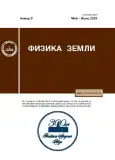Evolution of Sliding Along a Heterogenous Fault. A Large-Scale Laboratory Experiment.
- Authors: Gridin G.A.1, Kocharyan G.G.1, Morozova K.G.1, Novikova E.V.1, Ostapchuk A.A.1, Pavlov D.V.1
-
Affiliations:
- Sadovsky Institute of Geosphere Dynamics, Russian Academy of Sciences
- Issue: No 3 (2023)
- Pages: 139-147
- Section: Articles
- URL: https://journals.rcsi.science/0002-3337/article/view/139030
- DOI: https://doi.org/10.31857/S0002333723030043
- EDN: https://elibrary.ru/JZVXSK
- ID: 139030
Cite item
Full Text
Abstract
A laboratory setup was constructed in IDG RAS to investigate the process of shearing the contact of rock blocks of one-meter scale. It was used to investigate deformation processes in a fault with a heterogenous structure of the sliding interface, which contained strong contact patches – analogs of the “asperity” in the model of Hiroo Kanamori. It is shown that when a large slip occurs, the rupture, that starts in the zone of maximal deficit of interblock displacement, cuts the segments of the fault with lower effective strength, the latter being decreased in previous deformation events. Those previous events may be “slow” slips with low seismic efficiency. In nature the events that “prepare” the fault interface for a large slip may be smaller earthquakes – foreshocks, or they can be either low frequency earthquakes or slow slip events, both can hardly be detected in seismic records. Thereupon a promising diagnostic indication is the shift of the spectrum of ambient seismic noise to lower frequencies caused by the decrease of fault stiffness.
About the authors
G. A. Gridin
Sadovsky Institute of Geosphere Dynamics, Russian Academy of Sciences
Email: ostapchuk.aa@idg.ras.ru
119334 Russia, Moscow
G. G. Kocharyan
Sadovsky Institute of Geosphere Dynamics, Russian Academy of Sciences
Email: ostapchuk.aa@idg.ras.ru
119334 Russia, Moscow
K. G. Morozova
Sadovsky Institute of Geosphere Dynamics, Russian Academy of Sciences
Email: ostapchuk.aa@idg.ras.ru
119334 Russia, Moscow
E. V. Novikova
Sadovsky Institute of Geosphere Dynamics, Russian Academy of Sciences
Email: ostapchuk.aa@idg.ras.ru
119334 Russia, Moscow
A. A. Ostapchuk
Sadovsky Institute of Geosphere Dynamics, Russian Academy of Sciences
Author for correspondence.
Email: ostapchuk.aa@idg.ras.ru
119334 Russia, Moscow
D. V. Pavlov
Sadovsky Institute of Geosphere Dynamics, Russian Academy of Sciences
Email: ostapchuk.aa@idg.ras.ru
119334 Russia, Moscow
References
- Беседина А.Н., Кишкина С.Б., Кочарян Г.Г., Ряховский И.А. Анализ микросейсмического фона до и после сильных землетрясений на примере Чилийской зоны субдукции // Физика Земли. 2020. № 2. С. 10–20.
- Добровольский И.П. Теория подготовки тектонического землетрясения. М.: Наука. 1991. 218 с.
- Кочарян Г.Г. Возникновение и развитие процессов скольжения в зонах континентальных разломов под действием природных и техногенных факторов. Обзор современного состояния вопроса // Физика Земли. 2021. № 4. С. 3–41. https://doi.org/10.31857/S0002333721040062
- Кочарян Г.Г., Батухтин И.В. Лабораторные исследования процесса скольжения по разлому как физическая основа нового подхода к краткосрочному прогнозу землетрясений // Геодинамика и тектонофизика. 2018. Т. 9. № 3. С. 671–691. https://doi.org/10.5800/GT-2018-9-3-0367
- Кочарян Г.Г., Иванченко Г.Н., Кишкина С.Б. Энергия, излучаемая сейсмическими событиями различного масштаба и генезиса // Физика Земли. 2016. № 4. С. 141–156
- Кочарян Г.Г., Остапчук А.А., Павлов Д.В., Гридин Г.А., Морозова К.Г., Hongwen J., Пантелеев И.А. Лабораторные исследования закономерностей фрикционного взаимодействия блоков скальной породы метрового масштаба. Методика и первые результаты // Физика Земли. 2022. № 6. С. 162–174
- Bürgmann R. The Geophysics, geology and mechanics of slow fault slip // Earth and Planetary Science Letters. 2018. V. 495. P. 112–134. https://doi.org/10.1016/j.epsl.2018.04.062
- Gomberg J. Unsettled earthquake nucleation // Nat. Geosci. 2018. V. 11. P. 463–464. https://doi.org/10.1038/s41561-018-0149-x
- Kanamori H., Stewart G.S. Seismological aspects of the Guatemala earthquake of February 4, 1976 // J. Geophysical Research: Solid Earth. 1978. V. 83. № B7. P. 3427–3434. https://doi.org/10.1029/JB083iB07p03427
- Kocharyan G.G., Ostapchuk A.A., Pavlov D.V. Traces of laboratory earthquake nucleation in the spectrum of ambient noise // Sci. Rep. 2018. V. 8. P. 10764. https://doi.org/10.1038/s41598-018-28976-9
- Obara K., Kato A. Connecting slow earthquakes to huge earthquakes // Science. 2016. V. 353. P. 253–257. https://doi.org/10.1126 /science.aaf1512
- Peng Z., Gomberg J. An integrated perspective of the continuum between earthquakes and slow-slip phenomena // Nature Geoscience. 2010. V. 3. № 9. P. 599–607. https://doi.org/10.1038/ngeo940
- Radiguet M., Perfettini H., Cotte N., Gualandi A., Valette B., Kostoglodov V., Lhomme T., Walpersdorf A., Cabral Cano E., Campillo M. Triggering of the 2014 Mw7.3 Papanoa earthquake by a slow slip event in Guerrero, Mexico // Nat. Geosci. 2016. V. 9. P. 829–833. https://doi.org/10.1038 /ngeo2817
- Scholz C.H. The mechanics of earthquakes and faulting 3rd edition. Cambridge. UK: Cambridge University Press. 2019. 517 p.
- Scholz C. H., Campos J. The seismic coupling of subduction zones revisited // J. Geophys. Res. 2012. V. 117. B05310. https://doi.org/10.1029/2011JB009003
- Sibson R.H. Thickness of the Seismic Slip Zone // Bulletin of the Seismological Society of America. 2003. V. 93. № 3. P. 1169–1178. https://doi.org/10.1785/0120020061
Supplementary files
















